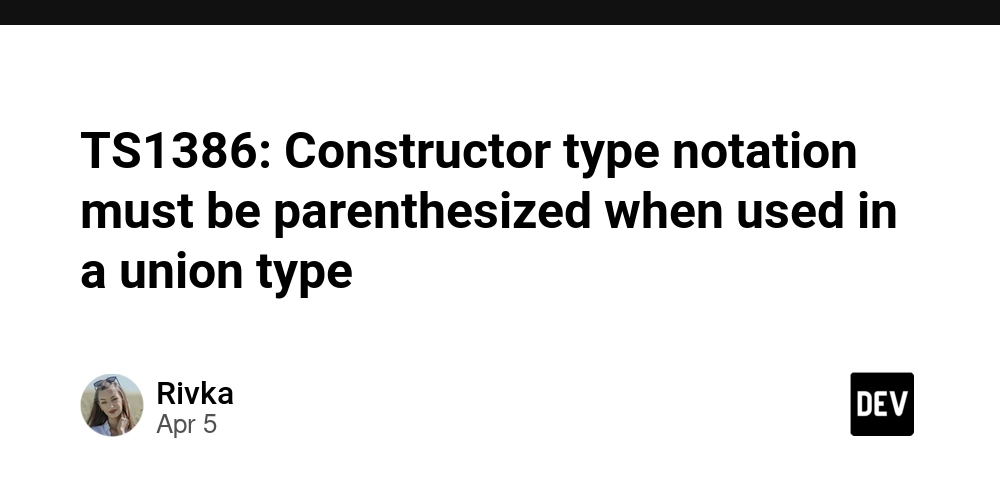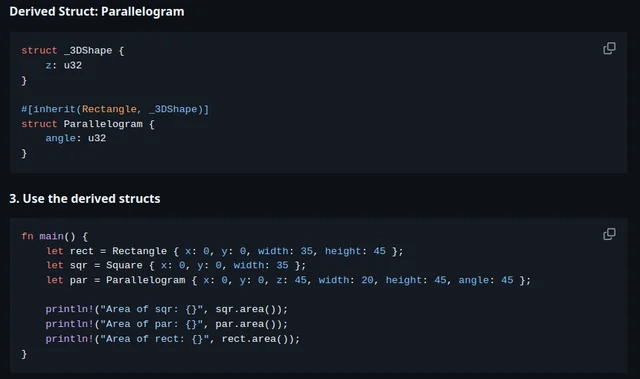TS1386: Constructor type notation must be parenthesized when used in a union type
TS1386: Constructor type notation must be parenthesized when used in a union type TypeScript is a powerful superset of JavaScript that adds static types. It allows developers to catch errors at compile time rather than at runtime, making it a valuable tool for building robust applications. Types in TypeScript refer to the different data types that variables can hold, including primitives like numbers and strings, as well as more complex structures like arrays and objects. If you want to deepen your understanding of TypeScript or leverage AI tools like gpteach to learn how to code effectively, consider subscribing to my blog for more insights. What are Types? Types are essential in TypeScript because they define the shape and behavior of data. They help developers understand what kind of data can be passed around in their programs, minimizing runtime errors. Types can be primitive (like number, string, and boolean), complex (like arrays and objects), or even custom types defined by the user (using interfaces, types, or enums). Now, let’s delve into the TypeScript-specific error: TS1386: Constructor type notation must be parenthesized when used in a union type. Understanding TS1386 The error TS1386: Constructor type notation must be parenthesized when used in a union type typically arises when you are defining a type that is a union of constructors, but fail to properly parenthesize the constructor types. In TypeScript, constructors can be represented as types, and when using them in a union, they must be wrapped in parentheses to clarify their precedence. Example That Causes the Error Here’s a code example that would trigger the TS1386 error: class Dog { } class Cat { } type Animal = Dog | Cat; // This line will cause the TS1386 error type Creator = Animal | (() => Animal); In this code, we might expect to pass two different types, but TypeScript requires that constructor types in unions are parenthesized. How to Fix It To resolve the issue, you need to wrap the constructor types in parentheses. Here's how you can correctly define the Creator type: class Dog { } class Cat { } type Animal = Dog | Cat; // Notice the parentheses around the constructors type Creator = (new () => Animal) | (() => Animal); Now, we correctly define a union of constructor functions that return either a Dog or a Cat. Important to Know! Parentheses Matter: In TypeScript, when dealing with unions involving constructors, always remember to use parentheses. Union Types: When creating union types, many developers assume TypeScript can infer precedence. Not always true, especially with constructors! Frequently Asked Questions What happens if I don’t parenthesize properly? You will encounter compile-time errors, which can be confusing if you are not aware of the need for parentheses. Can I have multiple constructor types in a union? Yes! Just make sure to parenthesize each constructor type as needed. What are the common types that I might use in a union? You can use classes, interfaces, or even function types within union types, but always watch out for the need for parentheses with constructors. Conclusion The error TS1386: Constructor type notation must be parenthesized when used in a union type serves as a helpful reminder about the importance of clarity in type definitions. By ensuring that our constructor types are properly parenthesized, we can leverage TypeScript's powerful type system without running afoul of common pitfalls. To recap, remember: Always use parentheses when defining union types that include constructors. Be mindful of TypeScript’s strict typing; it is there to help you develop better code. If you’re interested in more TypeScript insights or related tutorials, don’t forget to follow my blog for continuous learning!

TS1386: Constructor type notation must be parenthesized when used in a union type
TypeScript is a powerful superset of JavaScript that adds static types. It allows developers to catch errors at compile time rather than at runtime, making it a valuable tool for building robust applications. Types in TypeScript refer to the different data types that variables can hold, including primitives like numbers and strings, as well as more complex structures like arrays and objects.
If you want to deepen your understanding of TypeScript or leverage AI tools like gpteach to learn how to code effectively, consider subscribing to my blog for more insights.
What are Types?
Types are essential in TypeScript because they define the shape and behavior of data. They help developers understand what kind of data can be passed around in their programs, minimizing runtime errors. Types can be primitive (like number, string, and boolean), complex (like arrays and objects), or even custom types defined by the user (using interfaces, types, or enums).
Now, let’s delve into the TypeScript-specific error: TS1386: Constructor type notation must be parenthesized when used in a union type.
Understanding TS1386
The error TS1386: Constructor type notation must be parenthesized when used in a union type typically arises when you are defining a type that is a union of constructors, but fail to properly parenthesize the constructor types. In TypeScript, constructors can be represented as types, and when using them in a union, they must be wrapped in parentheses to clarify their precedence.
Example That Causes the Error
Here’s a code example that would trigger the TS1386 error:
class Dog { }
class Cat { }
type Animal = Dog | Cat;
// This line will cause the TS1386 error
type Creator = Animal | (() => Animal);
In this code, we might expect to pass two different types, but TypeScript requires that constructor types in unions are parenthesized.
How to Fix It
To resolve the issue, you need to wrap the constructor types in parentheses. Here's how you can correctly define the Creator type:
class Dog { }
class Cat { }
type Animal = Dog | Cat;
// Notice the parentheses around the constructors
type Creator = (new () => Animal) | (() => Animal);
Now, we correctly define a union of constructor functions that return either a Dog or a Cat.
Important to Know!
- Parentheses Matter: In TypeScript, when dealing with unions involving constructors, always remember to use parentheses.
- Union Types: When creating union types, many developers assume TypeScript can infer precedence. Not always true, especially with constructors!
Frequently Asked Questions
-
What happens if I don’t parenthesize properly?
- You will encounter compile-time errors, which can be confusing if you are not aware of the need for parentheses.
-
Can I have multiple constructor types in a union?
- Yes! Just make sure to parenthesize each constructor type as needed.
-
What are the common types that I might use in a union?
- You can use classes, interfaces, or even function types within union types, but always watch out for the need for parentheses with constructors.
Conclusion
The error TS1386: Constructor type notation must be parenthesized when used in a union type serves as a helpful reminder about the importance of clarity in type definitions. By ensuring that our constructor types are properly parenthesized, we can leverage TypeScript's powerful type system without running afoul of common pitfalls.
To recap, remember:
- Always use parentheses when defining union types that include constructors.
- Be mindful of TypeScript’s strict typing; it is there to help you develop better code.
If you’re interested in more TypeScript insights or related tutorials, don’t forget to follow my blog for continuous learning!







































































































































































![[The AI Show Episode 143]: ChatGPT Revenue Surge, New AGI Timelines, Amazon’s AI Agent, Claude for Education, Model Context Protocol & LLMs Pass the Turing Test](https://www.marketingaiinstitute.com/hubfs/ep%20143%20cover.png)




































































































































![From drop-out to software architect with Jason Lengstorf [Podcast #167]](https://cdn.hashnode.com/res/hashnode/image/upload/v1743796461357/f3d19cd7-e6f5-4d7c-8bfc-eb974bc8da68.png?#)










































































































.jpg?#)





.png?width=1920&height=1920&fit=bounds&quality=70&format=jpg&auto=webp#)
























_ArtemisDiana_Alamy.jpg?#)















































































-xl.jpg)













![Yes, the Gemini icon is now bigger and brighter on Android [U]](https://i0.wp.com/9to5google.com/wp-content/uploads/sites/4/2025/02/Gemini-on-Galaxy-S25.jpg?resize=1200%2C628&quality=82&strip=all&ssl=1)












![Apple Rushes Five Planes of iPhones to US Ahead of New Tariffs [Report]](https://www.iclarified.com/images/news/96967/96967/96967-640.jpg)
![Apple Vision Pro 2 Allegedly in Production Ahead of 2025 Launch [Rumor]](https://www.iclarified.com/images/news/96965/96965/96965-640.jpg)































































































































